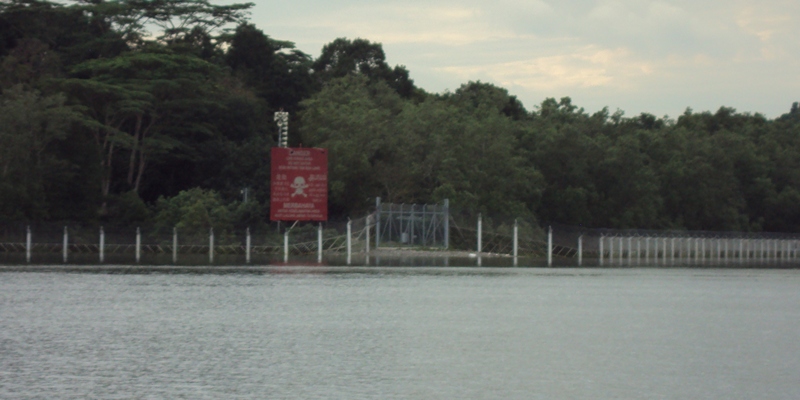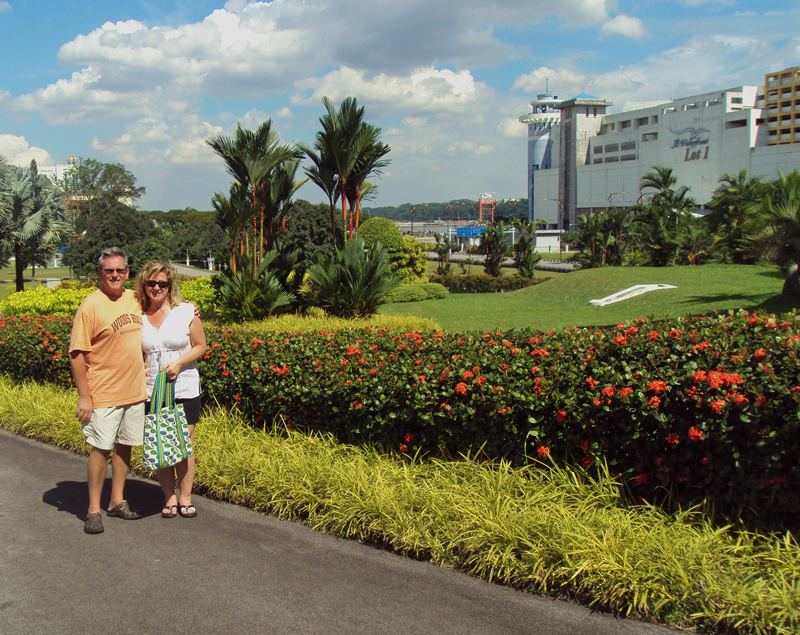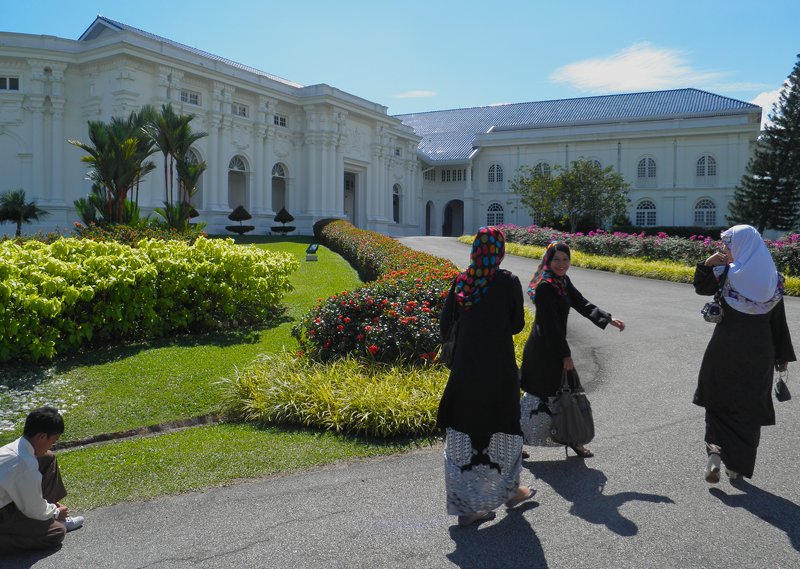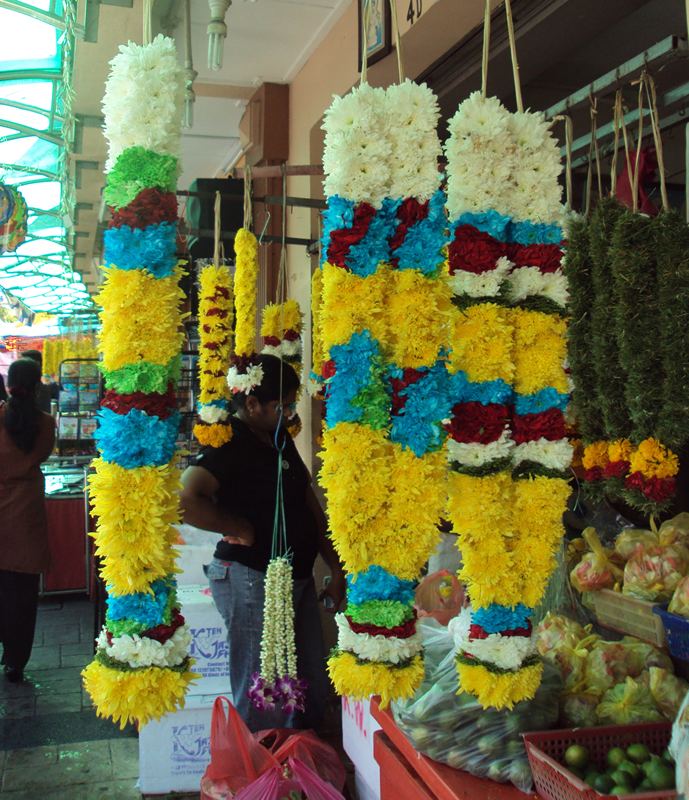Almost, but Not Quite - Danga Bay, Johor State, Malaysia

Harmonie
Don and Anne Myers
Sun 21 Nov 2010 02:38
|
01:28.383N 103:43.411E
On the second day of Bryan and Michele's excellent adventure
(November 1), we ventured out of our first-world sanctuary at Raffles Marina in
Singapore and sailed, yes, sailed, 10 miles up the Johor Strait to Danga Bay in
Malaysia. It was then that we congratulated Bryan and
Michele for bringing us good luck and good wind for the first time in
ages. Of course it was only 10 miles and 2 hours, but a sail is a
sail, after all. It wasn't until a day or two later that we realized
it was possible good luck wasn't exactly what Bryan and Michele brought - but
that's a story for another time.
About Malaysia...
With a population of 24.4 million (roughly the same as
Australia, but much more densely populated) split primarily between Malay (62%),
Chinese (24%) and Indian (7%), the country is unique in its
multiculturalism. This makes for really good food, lots of holidays
(everything from Christmas, Ramadan, the Indian Festival of Lights to
Chinese New Year), and historically, some strife between cultural
groups. As in most of Southeast Asia, the Portuguese arrived in
the early 1500's, followed by the Dutch in the 1600's and the British in the
1700's and 1800's. In 1824, The British and Dutch carved up the region
into what is now Indonesia (under Dutch control until 1949) and Malaysia (under
British control until 1957).
We've only spent a few weeks in Malaysia, but our impression
thus far is that Malaysia gets it just about right, nearly perfect in
fact, with the exception of one, usually critical, element. The
best example we've run into so far is the marina near the city of
Georgetown on the island of Penang. Newly built in a perfect location
close to the center of town with solid docks, excellent boater lounge,
bathrooms, laundry facilities and restaurants.......but no break wall. All
good until swell from the northwest starts rolling down the channel between
Penang and the mainland, and directly into the marina. Not pretty.
More on this in a future blog entry, but for now, suffice it to say that
Malaysia seems to be trying hard, but just isn't quite there
yet.
From a strictly economic point of view, if Singapore is a
10 on a scale of 1 to 10, and Indonesia is a 2, then Malaysia is a 5
or 6. We've seen lots of fishermen, but their boats are larger and
more powerful than those we typically saw in Indonesia. No
double-outrigger sailing canoes used for fishing here.
We also haven't seen any homes built with traditional materials
(bamboo and palm fronds with dirt floors), and the number of cars flying around
the surprisingly good roads almost exceed that of motorcycles and
mopeds. The people are friendly, but not overwhelmingly so like the
Indonesians. We definitely don't cause a stir when we walk around a
Malaysian town or city - the only citizens that seem to be interested in us at
all are the taxi drivers looking for work. It's not like any of
this is bad, it's just that the royal treatment we received in Indonesia is
making it that much harder for us to readjust to reality.
Our destination on November 1, the Danga Bay Marina, is
another example of the almost-but-not-quite nature of Malaysia. Another
brand new marina with nice docks, newly installed shore power and good
restaurants, but no break wall and too-scary-to-use bathrooms. No
complaints from us though because the dockage was free and we paid only the
equivalent of $6 for the electricity we used over the course of our 3 night
stay. We would have preferred to stay only 2 nights, but the process of
checking into Malaysia, filling up with 250 liters of diesel using jerry
cans, sorting out new sim cards for our cell phone and internet modem, and
then clearing out of the nearby Johor Baru port (like Indonesia, yachts are
required to check into and out of every major port) took longer than we
thought it would.
Although we stayed longer than planned, it was good timing in
that all 68 Sail Malaysia boats were also docked in the Danga Bay
Marina. We joined the Sail Malaysia rally (as did most of the other
Sail Indonesia rally participants), but decided it was probably a
better idea to travel ahead of the rally at a faster pace to
reach destinations like Malaka, Penang and Langkawi before the
crowd. So we basically skipped the Malaysia rally, but did have a few
days in Danga Bay to catch up with many of the boaters we hadn't seen since the
last official Sail Indonesia stop in Belitung three weeks before. It was a
bit of a homecoming for us and Bryan and Michele were surprised by the
larger than expected boater community we tend to travel around
with.
It might be a nice place for a homecoming, but Danga Bay
is not beautiful. The Johor Strait is a muddy brown strip of water that
separates the southern tip of Malaysia from the island of Singapore. The
neighboring seedy amusement park and rundown strip mall don't inspire
superlatives either. The restaurants, however, weren't too bad and we
particularly liked the Chinese run and owned Italian restaurant that served
pizzas and supplied Malaysia's Tiger beer complete with cute, young 'Tiger
girls' in short skirts to pour it for us. Don and Bryan ordered a fair
amount of beer that night so we got to see a lot of the Tiger
girls.
While Don wrestled with boat projects, Bryan, Michele and
I had a chance to take a closer look at the city of Johor Baru, a
short cab ride away. Below are pictures:
 This is our view of Singapore Island as we sailed by in the
Johor Strait on the way to Danga Bay. From what we could tell, the whole
of Singapore's perimeter lining the Johor Strait is equipped with an
electric fence. If that isn't enough to deter someone from illegally
entering the country, the skull and crossbones signs with warnings written in
three languages, and the Singapore Coast Guard boats lying in wait every
few miles might do the trick.
 Bryan and Michele in the gardens leading up to what is now a
museum, but what used to be the Sultan of Johor's palace.
 A group of school children and their Muslim teachers walking
toward the sultan's palace. The palace is kept much as it was when the
sultan and his family were living there. Built in 1866 to resemble a
Victorian mansion, the palace comes complete with a throne room (the thrones are
hand carved wood, painted in gold leaf), several grandiose dining areas, many
bedrooms, a meeting room, and to the delight of the three of us (sarcasm used
here), a hunting trophy room. There, we saw three stuffed Bengal tigers
(now extinct), eight elephant skulls, countless elephant tusks, a stuffed
crocodile and many pieces of furniture made from the limbs of dead
animals. Let's see, there was the elephant foot ash tray and the
giraffe leg lamp among other atrocities. It was so distasteful the
three of us were completely mesmerized. To be fair, animal conservation
was not necessarily in vogue at the time of the sultan's reign.
 We wandered through the street stalls of Johor Baru and found
the jumble of fruit, satay, jewelry, sari, sarong, knock-off
watch, purse, and sunglass stalls to be like walking through an
obstacle course in a carnival funhouse. The smells were good, the
colors outrageous and the energy high. It was our
first experience with what we felt was the real Malaysia. The
stall pictured above was selling real flower leis - perhaps to be worn at the
upcoming Indian Festival of Lights celebration.
Anne
|